Urban coats of arms
How do you represent a city?
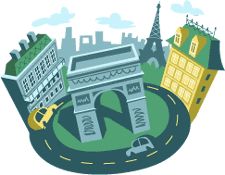
What decisions would you make – graphically, textually, even musically – in order to produce something sufficiently emblematic of an urban experience, something people all over the world could recognize and relate to?
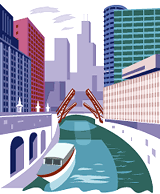
[Image: Need a hint? Think Oprah].
If you had to represent New York, for instance – or London, or Shanghai, or New Orleans – or Atlantis, for that matter – what, first of all, does such a question even mean? How do you "represent" "Shanghai"?
"You."
Well, let's just say that we've answered those questions: what, then, would you choose? The people? The landscape? The skyline?
The architecture?
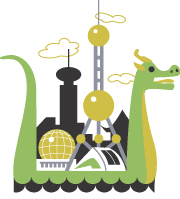
A series of digital city guides, produced by The Economist, uses unique graphic emblems to represent each city under discussion – in the process, making clear artistic decisions about what does or does not constitute "London" or "Sydney" or "Tokyo."
Overwhelmingly (if unsurprisingly), these graphics – like urban coats of arms for the 21st century – choose landmark architectural sites and streetscapes for their centerpiece.
From the obvious –
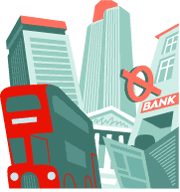

– to the slightly less obvious –
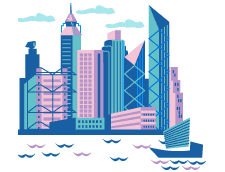
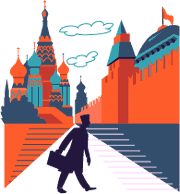

(why obscure Berlin's TV tower in clouds? why not include the Reichstag? and is that really the best Brandenburg Gate they could draw?)

(here, why hide the Golden Gate Bridge to focus on a cable car – which, as drawn, looks like every other tram on earth?)
– to the downright ugly –
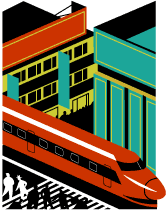
(that's Tokyo!)

(Dubai!)
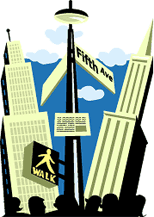
(is that a UFO invading New York? why not a flaming World Trade Center?)
– to the surreal or overly abstract:


Those last two? Mexico City and Toronto.
Bilbao, Rome, Rio, Las Vegas, Montreal, Marrakech, Cairo, Baghdad – all emblemizable, so to speak: but what would those emblems depict? And what of so-called minor cities, from Glasgow to Winnipeg, Frankfurt to Xian?
What about The City of Lost Children?
What about Guantanamo Bay?
If we were to develop a new series of international coats of arms for all our global cities, what buildings or spaces or skylines – or bodies of water, or atmospheric events, or exposed geological formations, or even emblematic animals or famous disasters – earthquakes, fires, floods, terrorist attacks, atom bombs – would be included?
How do you represent a city?

What decisions would you make – graphically, textually, even musically – in order to produce something sufficiently emblematic of an urban experience, something people all over the world could recognize and relate to?

[Image: Need a hint? Think Oprah].
If you had to represent New York, for instance – or London, or Shanghai, or New Orleans – or Atlantis, for that matter – what, first of all, does such a question even mean? How do you "represent" "Shanghai"?
"You."
Well, let's just say that we've answered those questions: what, then, would you choose? The people? The landscape? The skyline?
The architecture?

A series of digital city guides, produced by The Economist, uses unique graphic emblems to represent each city under discussion – in the process, making clear artistic decisions about what does or does not constitute "London" or "Sydney" or "Tokyo."
Overwhelmingly (if unsurprisingly), these graphics – like urban coats of arms for the 21st century – choose landmark architectural sites and streetscapes for their centerpiece.
From the obvious –


– to the slightly less obvious –



(why obscure Berlin's TV tower in clouds? why not include the Reichstag? and is that really the best Brandenburg Gate they could draw?)

(here, why hide the Golden Gate Bridge to focus on a cable car – which, as drawn, looks like every other tram on earth?)
– to the downright ugly –

(that's Tokyo!)

(Dubai!)

(is that a UFO invading New York? why not a flaming World Trade Center?)
– to the surreal or overly abstract:


Those last two? Mexico City and Toronto.
Bilbao, Rome, Rio, Las Vegas, Montreal, Marrakech, Cairo, Baghdad – all emblemizable, so to speak: but what would those emblems depict? And what of so-called minor cities, from Glasgow to Winnipeg, Frankfurt to Xian?
What about The City of Lost Children?
What about Guantanamo Bay?
If we were to develop a new series of international coats of arms for all our global cities, what buildings or spaces or skylines – or bodies of water, or atmospheric events, or exposed geological formations, or even emblematic animals or famous disasters – earthquakes, fires, floods, terrorist attacks, atom bombs – would be included?
How do you represent a city?

Comments are moderated.
If it's not spam, it will appear here shortly!
...actually, that last one of Toronto is not abstract at all, but merely a stylized view from Center Island. And its a good drawing of our most iconic architecture: the CN tower and the Rogers Centre (formerly the SkyDome).
Going through the archives is fun!
Post a Comment